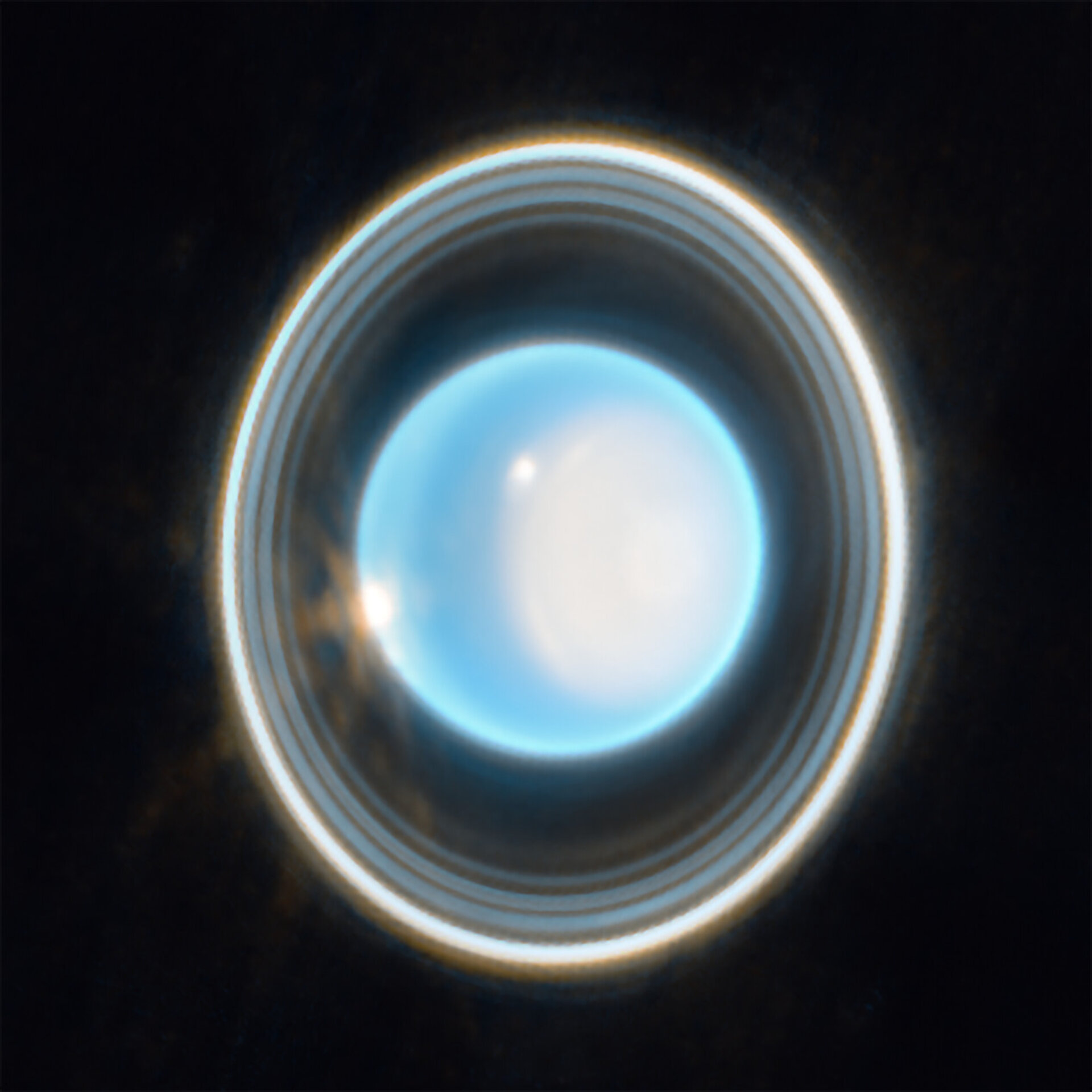Uranus is the seventh planet from the Sun. It is a gaseous cyan-coloured ice giant. Most of the planet is made of water, ammonia, and methane in a supercritical phase of matter, which in astronomy is called 'ice' or volatiles. The planet's atmosphere has a complex layered cloud structure and has the lowest minimum temperature of 49 K (−224 °C; −371 °F) out of all the Solar System's planets. It has a marked axial tilt of 82.23° with a retrograde rotation rate of 17 hours. This means that in an 84-Earth-year orbital period around the Sun, its poles get around 42 years of continuous sunlight, followed by 42 years of continuous darkness.
Uranus has the third-largest diameter and fourth-largest mass among the Solar System's planets. Based on current models, inside its volatile mantle layer is a rocky core, and surrounding it is a thick hydrogen and helium atmosphere. Trace amounts of hydrocarbons (thought to be produced via hydrolysis) and carbon monoxide along with carbon dioxide (thought to have been originated from comets) have been detected in the upper atmosphere. There are many unexplained climate phenomena in Uranus's atmosphere, such as its peak wind speed of 900 km/h (560 mph), variations in its polar cap and its erratic cloud formation. The planet also has very low internal heat compared to other giant planets, which is still unexplained.
Like the other giant planets, Uranus has a ring system, orbiting natural satellites and a magnetosphere. Its ring system is extremely dark, with only about 2% of the incoming light reflected, and contains the known 13 inner moons. Further out are the larger five major moons of the planet: Miranda, Ariel, Umbriel, Titania, and Oberon; and orbiting at much greater distance from Uranus are the known nine irregular moons. The planet's magnetosphere is highly asymmetric and has many charged particles, which may cause the darkening of its rings and moons.
Like Saturn, Jupiter, and Neptune, Uranus is a big ball of gas, often called a jovian or gas giant world. Uranus owes its vibrant blue-green hues not from unusual oceans but from an upper atmosphere flush with methane, which absorbs the sun's red light and scatters blue light back to our eyes.
The rest of planet's atmosphere is largely made of hydrogen and helium, with scant amounts of ammonia, water, and methane. Trace amounts of hydrogen sulfide also hint that, if you could visit this distant place without a spacesuit, the planet would smell like rotten eggs. While Saturn wears the crown for the least dense planet in our celestial family, Uranus is not far behind: Most of its mass is made up of an icy dense fluid of water, ammonia, and methane.
One particularly curious feature of Uranus is its off-kilter positioning. The gas giant is tipped on its side, spinning on its axis at nearly a right angle to its orbital path around the sun, which requires a lengthy 84 Earth-years to complete. Scientists believe that this unexpected tilt is the result of a massive collision with something the size of Earth far in the planet's past.
Thanks to its sideways turn, Uranus has some wild seasons, with the sun blazing across each pole for 21 Earth-years at a time while the opposing side lingers in the pitch blackness of space. And that's not the only strange thing about its spin. Like Venus, Uranus has what's known as a retrograde rotation, turning on its axis in the opposite direction to the rest of the planets.
TLDR:
Uranus smells stinky
Uranus spins on its side
Uranus spends 42 years in sunlight, 42 in darkness
Uranus has rings



